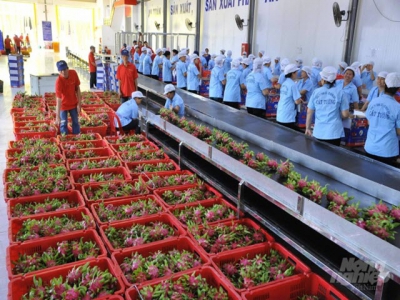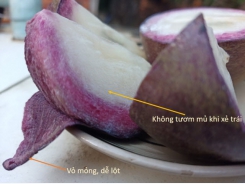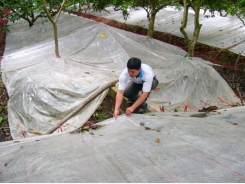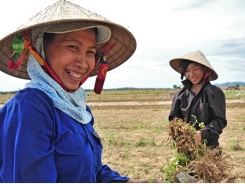The fourth order - Would China become the primary market for agricultural goods imports?

China is the nation with the greatest agricultural land scarcity, but it also has the fastest economic development rate, which means agricultural consumption will almost certainly increase in the coming years.
A dragon fruit processing line for export. Photo: Minh Sang.
It is clear that, throughout the course of the country's development, owing to its swift conquest of many markets, Vietnam's agricultural exports have grown at the fastest pace in the world and have rapidly improved its position in the global rankings.
However, because increasing agricultural product exports would be critical in solidifying the driving force behind agricultural growth in the future years, a market development orientation is required.
“Dual” accomplishments are advancing at a breakneck pace
Looking back on the 35 years of change, the first decade was particularly difficult, since agriculture played a unique role.
In the past two decades, reached USD 282.63 billion since 2020, exports continued to rise at a 16 percent annual pace on average, exceeding USD 262.7 billion, and imports growing at a 15.2 percent annual rate. The economy recorded a remarkable trade surplus of USD19.94 billion and a rate of 7.6 percent for the first time.
These accomplishments are without a doubt unparalleled in the world, since the average export growth rate of 18.7 percent per year over 35 years was the only one in the world, considerably surpassing the "Northern giant's" 13.9 percent per year.
In which, as stated in the country's first five-year plan, "the primary exports are agricultural and processed agricultural goods, aquatic products, and forest products," as well as orientations. "The most critical job for stabilizing the socioeconomic situation is to develop agriculture, forestry, and fisheries in combination with processing industry and new rural," the plan states, referring to the commodities group's overall export revenue.
It reached US$8.3 billion in the first five years of implementation, a 1.14-fold rise, accounting for 48.3 percent of the "export basket," while the decade as a whole reached USD25.8 billion, accounting for 37.4 percent and a 3.81-fold increase over the previous decade.
That is why, within 35 years, from a position of 95th, we have advanced an average of more than two positions per year to proudly join the world's top 20 exporting nations today.
Not only that, but perhaps even more significantly, the export of agricultural products ensures that, despite the economy's persistent trade deficit for the majority of the first three decades of renovation, the trade balance of this group of goods is always skewed toward exports, resulting in a total trade surplus of more than USD 271 billion over the 34-year period 1986–2019.
Three images - Two extremities
Our country's statistics indicate that dominating key export markets is becoming an increasingly essential objective. That example, if our country's three primary markets are China, the EU - 28 (EU), and the United Kingdom, they accounted for 39.8 percent of total revenue in 2001, but increased to 43.5 percent in 2010, and continued to grow to 52 percent in 2020.
In this regard, worldwide experience demonstrates that when the export size of agricultural goods is big with the prospect of further growth, it is critical to bolstering the near market's supremacy.
Specifically, WTO data indicate that 22 years ago, Mexico's agricultural exports were roughly $7.9 billion, ranking 19th in the world, but by 2019, they had increased to $39.75 billion, an average annual growth of 7.6 percent, propelling the country to 13th place.
It can be said categorically that the primary reason is that they consistently target the US market, thus converting the world's No. 2 agricultural product importing power, the US, into a "bag" for US agricultural goods.
The issue here is why a major agricultural exporting country's neighboring market with high buying power is "sucking" from it.
The answer, of course, can only be that, in addition to the abundant supply, it is relatively easy to win orders from the "giants," many agricultural products are perishable, live products with a short shelf life, transportation costs are prohibitively high, and the advantage of a close market is critical.
Meanwhile, despite the proximity of mountains and rivers to the "Northern behemoth," the world's largest agricultural importer since 2011, our country's agricultural exports to the market remain very low. This is very distinct.
That is, if our country's agricultural exports to this market accounted for only 14.5 percent of the "basket" of agricultural products exported to the world market 20 years ago, they now account for only 24.5 percent, which is undeniably less than the proportions of our two "forefathers" mentioned above. In the case of fruits and vegetables, our market share concerning China's total imports has dwindled dramatically over the last two decades, from 37.1 percent to just 17.1 percent.
In such circumstances, boosting agricultural exports in the future years may prioritize increased exploitation of key markets such as the US, EU, and other countries, with a particular emphasis on concurrent expansion into the Chinese market.
In summary, since the local agricultural product market is even more insufficient to support our agricultural output, it is essential to boost agricultural exports in the future years as a need.
And to do that, to capitalize on our proximity to China, maybe we cannot help but improve our market research to increase agricultural production. Not only that, but this is arguably the greatest strategy for reducing the enormous trade imbalance with this market, which has been growing at a breakneck pace in recent years.
Related news
Tools

Phối trộn thức ăn chăn nuôi

Pha dung dịch thủy canh

Định mức cho tôm ăn

Phối trộn phân bón NPK

Xác định tỷ lệ tôm sống

Chuyển đổi đơn vị phân bón

Xác định công suất sục khí

Chuyển đổi đơn vị tôm

Tính diện tích nhà kính

Tính thể tích ao




 Vietnam’s sweet bamboo see great potential for exports
Vietnam’s sweet bamboo see great potential for exports  Gender mainstreaming in agricultural extension to promote women’s…
Gender mainstreaming in agricultural extension to promote women’s…